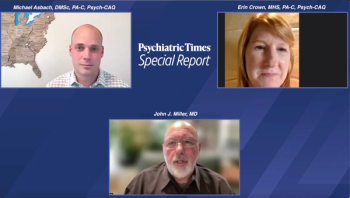
Treatment-Resistant Schizophrenia: Expert Interview
Recognizing treatment resistance early can raise the response rate from 30% to 80% in difficult-to-treat cases. in this video, Jonathan Meyer, MD, shares his top strategies to manage it with Chris Aiken, MD.
EXPERT Q&A
Treatment resistance is common in schizophrenia, and in this video, Jonathan Meyer, MD, shares his top strategies to manage it with Chris Aiken, MD.
Remission is rare in schizophrenia, but we should expect at least a 30% response with an antipsychotic trial. Some improvement can usually be seen after two weeks of a therapeutic dose. “Treatment resistance” is defined as failure to respond to two antipsychotic trials.
The first step is to check if the patient is actually taking the medication. Up to 35% are not when plasma levels are checked, and these can be ordered for most antipsychotics. Sometimes the patient is taking it, but a drug interaction or genetic variation has speeded up their metabolism of the drug, usually at CYP2D6 and CYP3A4. Severe stress and continued substance abuse are other factors to consider before diagnosing treatment resistance. (
Once treatment resistance is identified, a trial of clozapine is in order, and timing is of the essence here. The response rate with clozapine is 80% if it is started in the first 2.8 years of the illness, but that rate falls to 30% if it is started too late.
There is no standard titration with clozapine. Severe symptoms benefit from a faster titration, and clozapine can be raised faster in younger patients who can tolerate the orthostasis or in those who can be monitored closely in the hospital. The risk of neutropenia (1%) is well-known with clozapine, but equally important is constipation. This common adverse effect can become so severe as to cause illeus, which has an even greater fatality rate than neutropenia. Dr Meyer prescribes docusate preventatively when starting clozapine, and he recommends aggressive management if constipation arises.
Other nations use clozapine in 20% to 30% of patients with schizophrenia, but the US has fallen behind with a rate of only 5%. That is not enough to meet the need of treatment resistant patients, which account for 30% of schizophrenia. Clozapine gives those patients a chance at a fuller life. Its side effects are many, but most can be managed, and Dr Meyer provides practical resources for that in this video.
Dr Aiken is Instructor in Clinical Psychiatry at the Wake Forest University School of Medicine and the Director of the
Disclosures:
Dr Aiken does not accept honoraria from pharmaceutical companies but receives royalties from W.W. Norton & Co. for a book he co-authored with James Phelps, MD,
Newsletter
Receive trusted psychiatric news, expert analysis, and clinical insights — subscribe today to support your practice and your patients.











